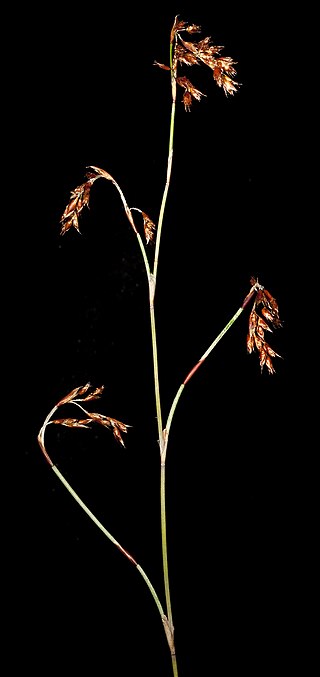
The Vitaceae are a family of flowering plants, with 14 genera and around 910 known species, including common plants such as grapevines and Virginia creeper. The family name is derived from the genus Vitis.

Canarium australianum, commonly known as scrub turpentine, is a species of tree in the family Burseraceae native to Australia and Papua New Guinea. Other common names include mango bark, carrot wood, parsnip wood, Melville Island white beech and brown cudgerie.

Ampelocissus is a genus of Vitaceae having 90 or more species found variously in tropical Africa, Asia, Central America, and Oceania. The type species, A. latifolia, was originally treated under its basionym, Vitis latifolia, and was collected from the Indian subcontinent.

Grewia retusifolia is a shrub species in the family Malvaceae. Common names include dysentery bush, emu-berry, dog's balls, turkey bush and diddle diddle. It is widespread in tropical and subtropical areas of Eastern Australia and Northern Western Australia. The species produces small, sweet, two-lobed fruit with a fibrous acidic pulp surrounding the seeds. Leichhardt described the fruits as having a very agreeable taste, which could be boiled to make a refreshing drink. Indigenous Australians use the bark and leaves in medications. The crushed leaves were used as a poultice to relieve toothaches.

Parinari nonda is a shrub or small tree in the family Chrysobalanaceae. It occurs in northern Australia and New Guinea. The edible fruits are harvested in the wild. Common names include nonda plum, nonda tree, nunda plum and parinari.

Cissus hypoglauca is a common Australian vine. It is one of the better known climbing plants of the genus Cissus in the grape family. A very common climber in moist areas of eastern Australia, it often colonises large areas after forest damage due to storms, fire or logging. Common names include jungle grape, water vine, giant water vine, five-leaf water vine, jungle vine, native grapes and billangai.
Ampelocissus africana is a type of vine that is woody, or liana of the grape family, bearing edible fruit. It is native to habitats in, and around forested areas in Guinea, Ivory Coast, Nigeria, Cameroon, Chad, Central African Republic, Sudan, Kenya, Rwanda, Burundi, Tanzania, Malawi, Zambia, Mozambique, Zimbabwe and Botswana. It was originally described botanically in 1790 by João de Loureiro as Botria africanus, which is the basionym for its treatment here under Ampelocissus.
Ampelocissus gracilipes, also known as abourbee (Akan-Twi), is a climbing vine or liana in the Grape family of tropical western Africa, in densely vegetative, forested areas.

Adenanthos linearis is a shrub of the family Proteaceae, native to the south coast of Western Australia. Within the genus Adenanthos, it lies in the section Adenanthos and has had only 14 known occurrences; only five of which have exact coordinates.

Carpobrotus aequilaterus, common names: angled pigface, Chilean pigface, This species is thought to have originated in southern Africa and a naturalised weed elsewhere. However, according to VicFlora it is native to South Africa, It is also known as the sea fig.

Fumaria capreolata, the white ramping fumitory or climbing fumitory, is an herbaceous annual plant in the poppy family Papaveraceae. It is native to Europe, western Asia and northern Africa and naturalised in southern Australia, New Zealand, and southern South America. Common names include also ramping fumitory, white fumitory, and white-flower fumitory.
Native grape may refer to certain plants within the family Vitaceae including:

Ammannia multiflora, commonly known as many-flower ammannia and jerry-jerry in Victoria, is a species in the family Lythraceae. It is widespread in Asia, tropical and sub-tropical Africa and Australia. It can be found in shallow water and damp heavy soils.

Rumex vesicarius, also known as Ruby dock, or bladder dock, is a species of perennial flowering plant in the family Polygonaceae. According to Plants of the World Online, Rumex vesicarius is native to tropical and temperate Asia, Africa, and Western Australia. However, the Council of Heads of Australasian Herbaria asserts that within Australia it is naturalised in Western Australia, the Northern Territory, South Australia, Queensland and New South Wales.

Amyema plicatula is a species of hemi-parasitic shrub found in the Bismarck Archipelago, New Guinea, New South Wales and Queensland.

Leptocarpus coangustatus is a species of plant in the Restionaceae (rush) family, endemic to Western Australia.

Schoenus variicellae is a species of sedge, first described in 1997 by Barbara Rye. It is native to Western Australia.

Sesbania formosa is a leguminous tree native to northern Australia, first described in 1860 by Ferdinand von Mueller as Agati formosum, from specimens collected the banks of the Victoria and Fitzmaurice Rivers. It was transferred to the genus, Sesbania, by Nancy Burbidge in 1965.

Anthelepis undulata is a plant in the Cyperaceae family, first described in 1804 by George Henry Kendrick Thwaites as Cladium undulatum with the current name being given in 2019 with a reassignment to the new genus, Anthelepis, by Russell Barrett, Karen Wilson and Jeremy Bruhl.
















